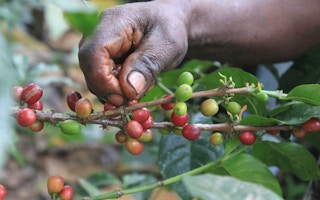My mother introduced us to coffee early, declaring that “it never killed anyone”. But I’m now rethinking coffee-drinking thanks to my husband’s breakfast time broken record about how my unnecessary habit is killing off owl monkeys and depleting precious water resources.
After previous efforts to quit my two-cup-a-day addiction proved woefully unsuccessful (note: it is a powerful mood enhancer!), I decided to investigate: if I want to live my environmental values, do I need to kick the coffee habit?
Coffee is riddled with sustainability challenges. Each cup of the beverage is estimated to need 140 litres of water to produce, and the water pollution resulting from wet processing contaminates waterways.
A 2012 study of 18 rivers in Ethiopia found negative long-term impacts on macroinvertebrates due to oxygen, nitrogen and organic matter from coffee wastewater. As my non-coffee-drinking colleague put it: “Coffee production endangers many not-so-cute animals too!”
Not to mention that the cherries, husks and grounds of coffee all contain valuable nutrients useful for myriad applications like flour, biofuel, and beauty products. Yet it is nearly impossible to find coffee companies harnessing that value at a large scale.
“
Cafes and big label brands idealise the small farmer, picking coffee cherries on the hills. In reality, the farmer is an underpaid, exploited coffee mascot.
The mass production of coffee through sun cultivation—where forests are cut down and coffee trees afforded full exposure to the sun—and illegal cultivation drives deforestation, soil degradation and infringes upon the habitats of endangered creatures from Colombia’s owl monkeys to Sumatra’s rhinos and tigers.
From a sustainable nutrition perspective, Central America’s prized coffees take up some of the richest volcanic soils for the production of a crop with little or no nutrient value, often in countries where some part of the population suffers from malnutrition.
Bird-friendly, shade-grown and Rainforest Alliance labels help, but they are often expensive and arduous to obtain for even the best, small cooperatives out there. Speciality label coffee gets sold at regular market prices anyway once the world coffee price drops, so there’s no guarantee of a return on the investment.
Cafes and big label brands idealise the small farmer, picking coffee cherries on the hills. But in reality, the farmer is an underpaid, exploited coffee mascot.
The growers’ price of coffee rarely exceeds US$1.50 per pound, which means that it is perfectly normal for less than 10 per cent of what the consumer pays for a bag of roasted coffee to go to the farmer.
Meanwhile, the farmers invest lifetimes in coffee production, spend months cultivating each year, and take on all the risk for bad harvests, pests and disease (the incidence of which is likely to increase due to climate change).
According to Australia’s Climate Institute: “By 2050, hotter weather and changes in rainfall patterns are projected to cut the area suitable for coffee by about 50 per cent across emissions scenarios.” So consumers will be paying more, but who is preparing the growers to adapt to a hotter world?
I’ll save the part about the emissions from the dairy products in your latte and go on to consider some options.
1. Cut down on coffee.
Due in part to a price that doesn’t reflect its environmental cost, coffee consumption—like beef consumption in many countries—has gotten completely out of hand, far in excess of what is actually needed for its cultural and social value. Try limiting your consumption to only special occasions or as treats, rather than a daily “fix”. And, of course, move away from the milk and cream.
2. Actively seek out coffee you believe in.
If you are lucky enough to visit a coffee producing country, go on a cooperative tour, meet some farmers and ask them questions about their practices, decide for yourself and built lasting relationships. Otherwise, do some research.
Many small coffee companies are now connecting you personally with growers so you can ask questions directly. Try to find female growers if you can. They routinely have less access to capital, land, training, etc. Advocate for the big guys to do better as well, and don’t give up asking questions about waste and water pollution; that’s the big one.
3. Favour coffee shops that favour environmentally friendly growers—and are doing something creative with coffee grounds.
If you primarily drink coffee while out and about, ask local roasters or coffee shops about where they get their coffee and their relationships to the growers. Plenty of people out there are trying to do the right thing by farmers and the environment. You probably don’t have to go far out of your way to support their efforts.
Do you have any other ideas? Please share them with me in a friendly and non-judgemental way, taking into account I’m an addict.
Gwyneth Fries is a senior strategist with Forum for the Future. This article was first published on Eco-Business with permission.


















